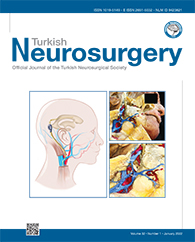MATERIAL and METHODS: A total of 106 patients with cerebral aneurysm who have undergone endovascular treatment (EVT) were included in this study, with a mean follow-up period of 17.2 months. Risk factors for IPR, such as the aneurysm?s location, size and morphology, etc. were evaluated, and the chi-squared test was used for statistical analysis. Clinical outcomes were assessed using the modified Rankin scale (mRS) at 15 months.
RESULTS: Among all 106 patients who have undergone EVT, five (4.7%) had aneurysmal IPR as well as ruptured aneurysms with subarachnoid haemorrhage (SAH). Among those five patients, primary coiling was performed in three cases and balloon/stentassisted coiling was performed in two cases, with complete occlusion of the aneurysmal sac achieved in four (4/5) patients. Clinical follow-up with the mRS scores of the patients revealed mortality in one patient (20%), favourable outcomes in three patients (60%) and unfavourable outcomes in one patient (20%).
CONCLUSION: Aneurysmal IPR is considered a rare but important complication of endovascular coiling that is associated with poor clinical outcomes. Several risk factors are significantly associated with IPR, such as small-sized aneurysm (<3.5 mm), presence of bleb and parent vessel tortuosity. Acom location, irregular shape and past episode of SAH also increase the risk of IPR, but such association was found to be statistically insignificant in our study. Although IPR is considered a devastating complication, good clinical outcomes can be achieved with early detection and proper management using rapid aneurysmal coil packing and occlusion.
Keywords : Aneurysm, Endovascular, Intraprocedural, Rupture, Risk factors




